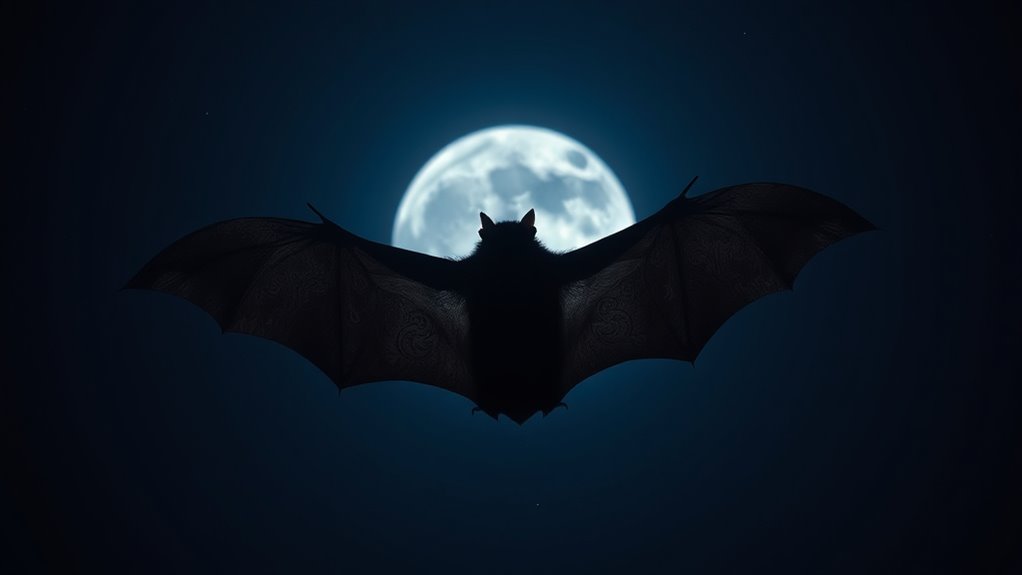Bats symbolize the mysteries of the night, representing both hidden knowledge and transformation. In many cultures, they’re seen as signs of rebirth and change, inspiring hope during dark times. However, misunderstandings often cast them as symbols of evil or death, especially in Western traditions. Their true significance is rich and complex, reflecting cycles of renewal and the unseen. Discover more about how these fascinating creatures embody hope, mystery, and cultural diversity as you explore further.
Key Takeaways
- Bats symbolize the night and the unknown, embodying mystery and hidden knowledge across cultures.
- They represent rebirth and transformation, linked to life’s cycles and personal change.
- Cultural perceptions of bats vary: Chinese symbolism views them as lucky, while Western views often associate them with darkness and death.
- Misunderstandings about bats stem from Gothic and vampire imagery, overshadowing their ecological importance.
- Bat symbolism encourages embracing change, hope, and appreciating unseen aspects of life beyond superficial fears.

Have you ever wondered what bats symbolize across different cultures? Their mysterious presence at dusk and their nocturnal habits have sparked a variety of symbolic meanings and cultural interpretations worldwide. In many traditions, bats are seen as symbols of the night, embodying the unseen and the unknown. Their ability to navigate in darkness suggests a sense of mystery and hidden knowledge, making them powerful symbols in stories and beliefs. For some, bats represent rebirth and transformation, reflecting their connection to the cycle of life and death. When a bat appears, it’s often viewed as a sign that change is coming or that you’re about to undergo a significant personal shift. This connection to renewal stems from their unique biology—by night, they emerge from caves or roosts into a new phase of life, symbolizing the idea of emergence and fresh starts.
Cultural interpretations of bats vary widely. In Chinese symbolism, bats are considered harbingers of good luck and prosperity because the word for bat, “fu,” sounds like the word for happiness and blessing. This positive symbolism has made bats a common motif in Chinese art and decor, where they’re seen as bringers of fortune. Conversely, in Western cultures, bats often carry a darker connotation. They’re frequently associated with death, darkness, and sometimes evil, largely because of their connection to vampires and Gothic stories. This negative symbolism can foster misunderstandings, leading many to see bats as sinister creatures, when in fact, they play crucial ecological roles, like controlling insect populations. The cultural interpretations reveal a complex web of beliefs—what’s viewed as a symbol of luck in one tradition might be seen as ominous in another.
These differing symbolic meanings highlight how cultural context shapes our perceptions of bats. Whether viewed as symbols of transformation, luck, or darkness, they challenge us to look beyond superficial fears and appreciate their true significance. Recognizing these cultural interpretations encourages a broader understanding of bats, moving past misconceptions rooted in fear and misunderstanding. Instead, you might see them as fascinating messengers of change, keepers of ancient wisdom, or creatures that remind us of the mysteries of the night. Their symbolism reminds us that what is often misunderstood can carry profound meanings, often reflecting the complex interplay between nature, culture, and human emotion. So, the next time you encounter a bat, consider the rich symbolism it carries across different traditions, and see it as more than just a creature of the night—see it as a symbol of transformation, hope, and the unknown.
Frequently Asked Questions
How Do Different Cultures Interpret Bat Symbolism Uniquely?
You’ll find that different cultures interpret bat symbolism uniquely, blending myth vs reality. In Chinese culture, bats symbolize good luck and happiness, representing cultural symbolism of prosperity. Conversely, Western societies often see bats as ominous, linked to darkness and fear. Indigenous cultures may view bats as spiritual guides or symbols of rebirth. These diverse interpretations show how cultural symbolism shapes perceptions, blending myth and reality in fascinating ways.
Are Bats Considered Good Luck or Bad Omens Historically?
In ancient rituals, bats were often seen as symbols of good luck, especially in Chinese culture, where they signaled prosperity and happiness. However, during the Middle Ages, supernatural beliefs cast bats as ominous creatures, warning of death or misfortune. Today, perceptions vary—some see them as helpful, others as bad omens. So, whether they’re lucky or unlucky depends on your cultural lens and historical moment.
What Are Common Misconceptions About Bats in Symbolism?
You might think superstitious beliefs paint bats as evil or ominous, but mythological stories often show them as symbols of rebirth and transformation. Many misconceptions stem from misunderstandings and fear rather than reality. Bats are actually associated with intuition and the night’s mysteries. By recognizing these mythological stories, you can see bats as positive symbols of renewal, not just creatures of darkness or bad luck.
How Does Bat Symbolism Relate to Personal Transformation?
Bat symbolism relates to your personal transformation by encouraging you to embrace your shadow work and pursue personal growth. Just as bats thrive in darkness, you can find strength in exploring your hidden fears and doubts. By facing your shadow, you open doors to rebirth and renewal, much like the bat’s association with night and rebirth. Embracing this symbolism helps you navigate change and emerge stronger.
Do Bat Symbols Have Spiritual Significance in Modern Practices?
Like shadows dancing at dusk, bat symbols hold spiritual significance in modern practices. You might see them as powerful emblems of intuition, rebirth, and mystery, echoing ancient myths where bats represented transition and hidden knowledge. In contemporary spiritual beliefs, people often incorporate bat symbolism to foster personal transformation, embracing the darkness to find light. These symbols remind you that through change, you can emerge renewed, much like bats steering the night.
Conclusion
So, next time you see a bat, remember it’s more than just a creature of the night. Its symbolism of rebirth, mystery, and misunderstood nature reminds us that what’s often unseen or misunderstood can hold deeper meaning. Sometimes, it’s no coincidence that a bat appears when you’re at a crossroads or seeking change. Embrace its message—trust the darkness, for it might just lead you to a new beginning you never expected.










